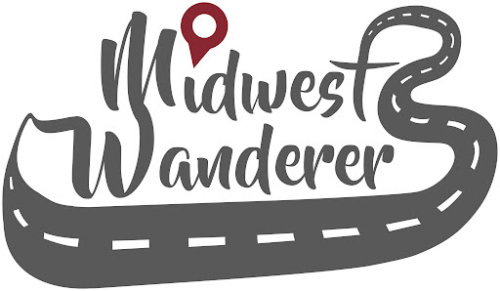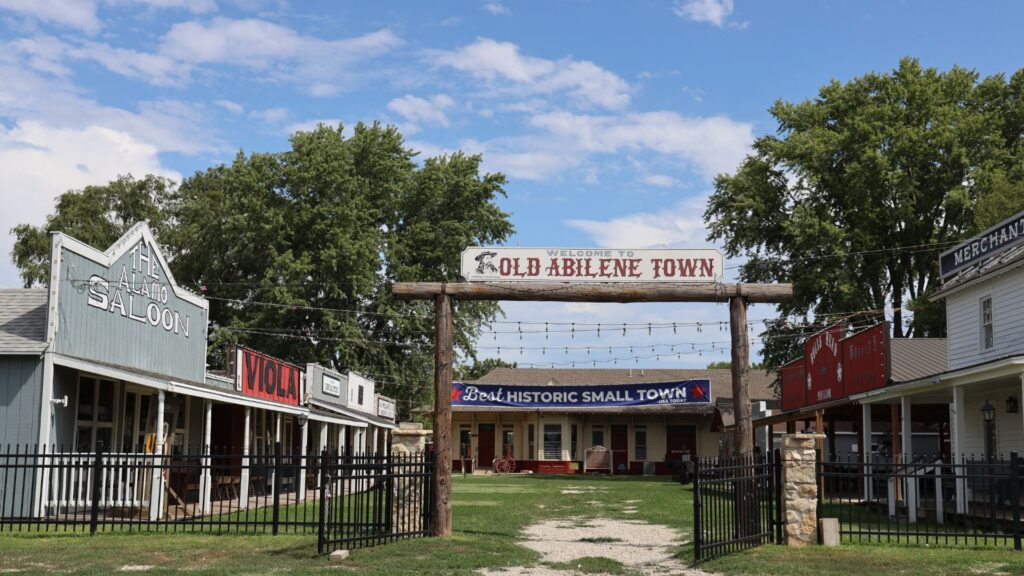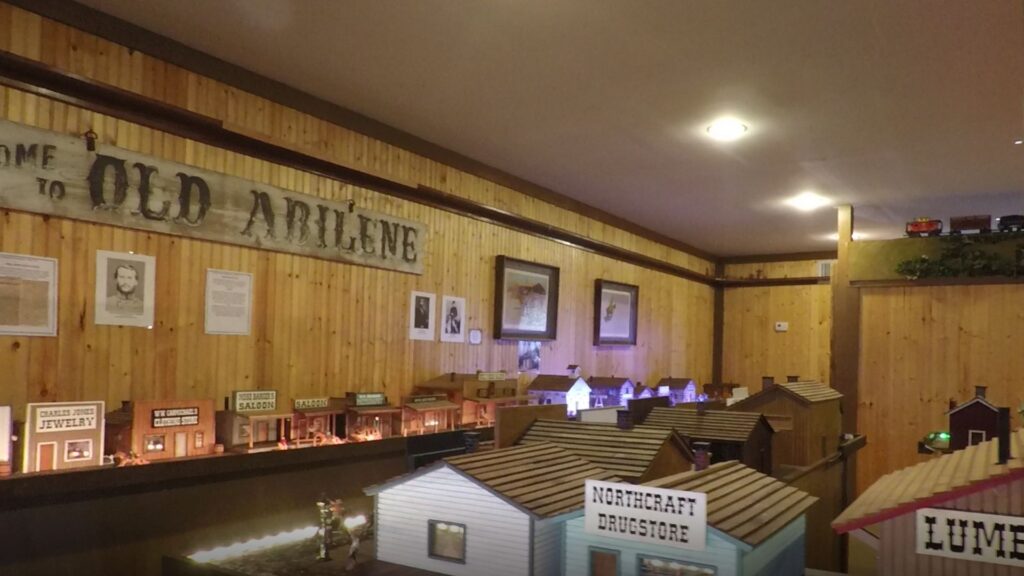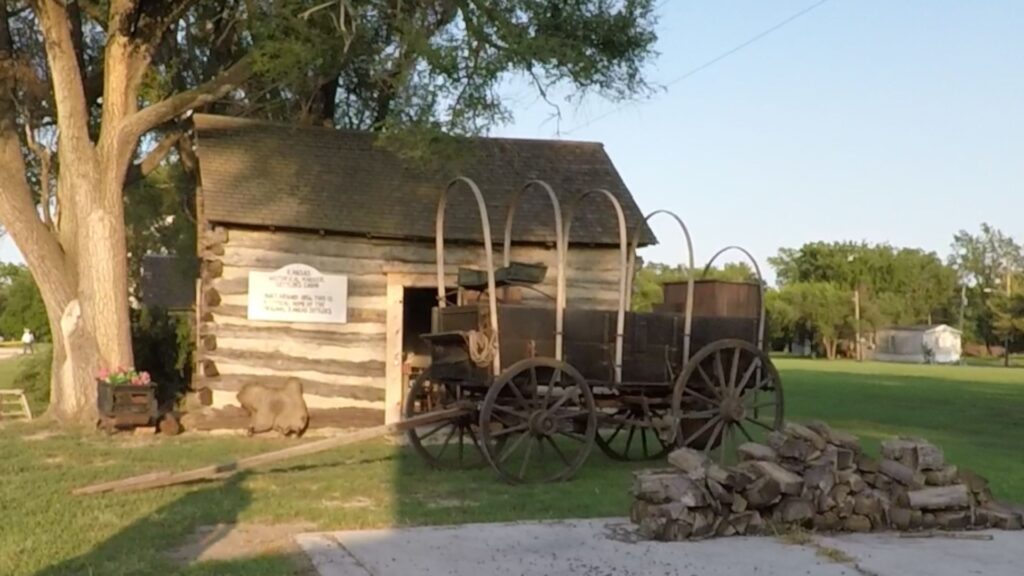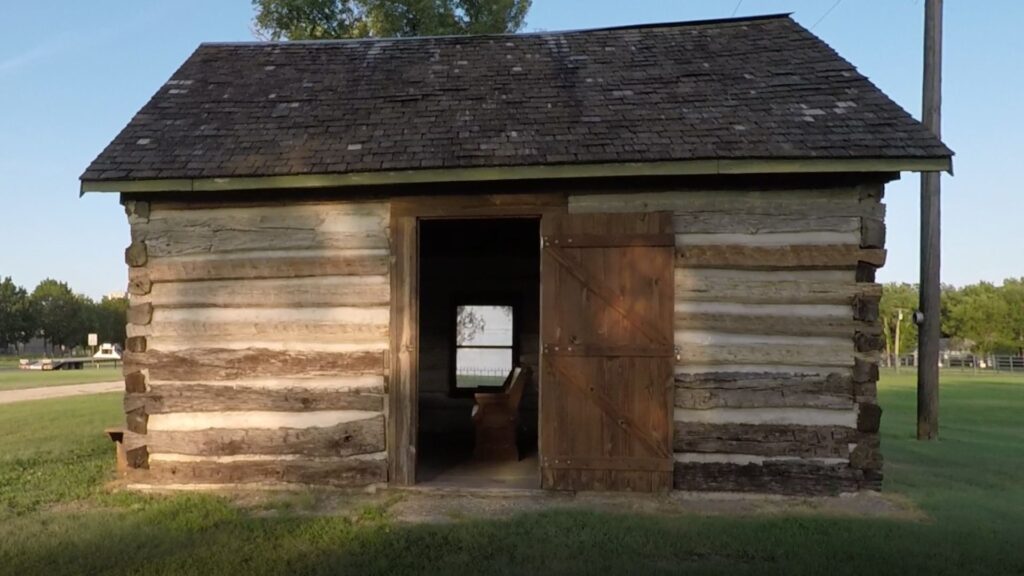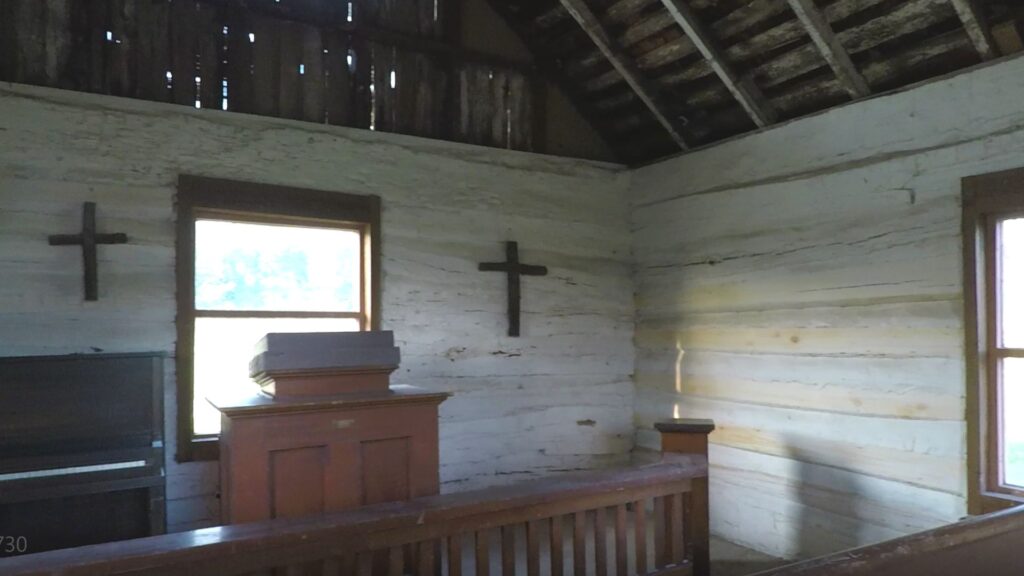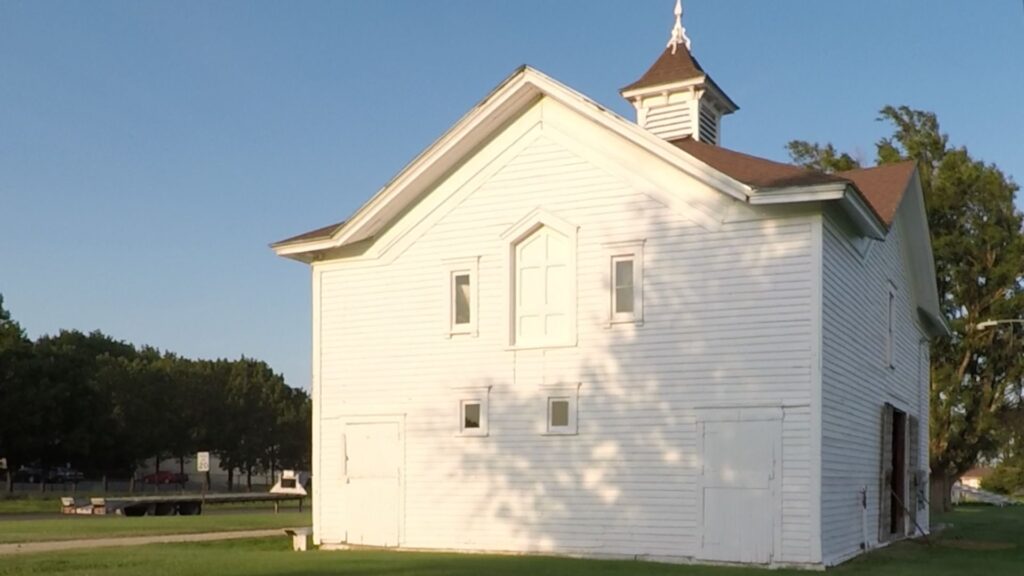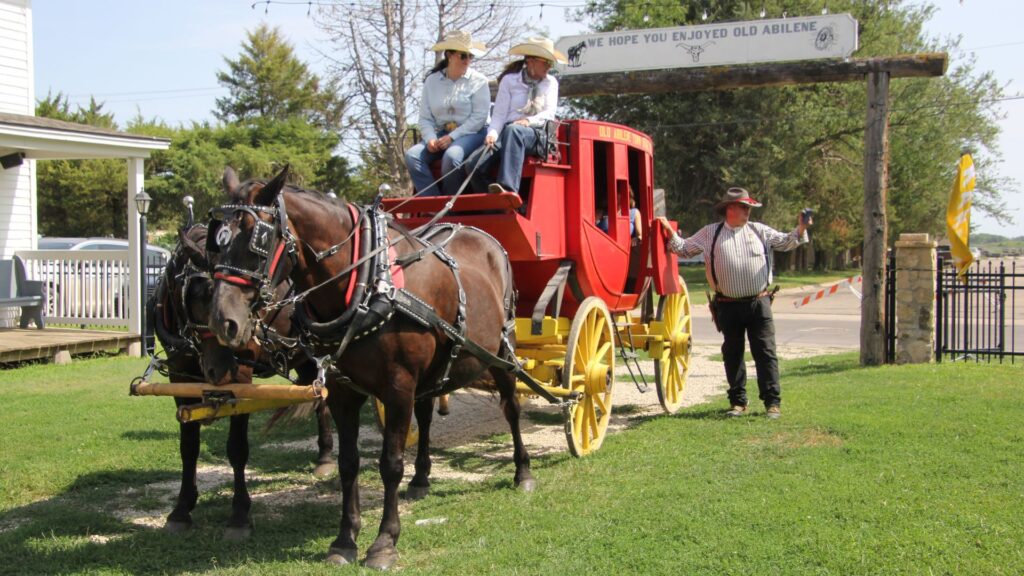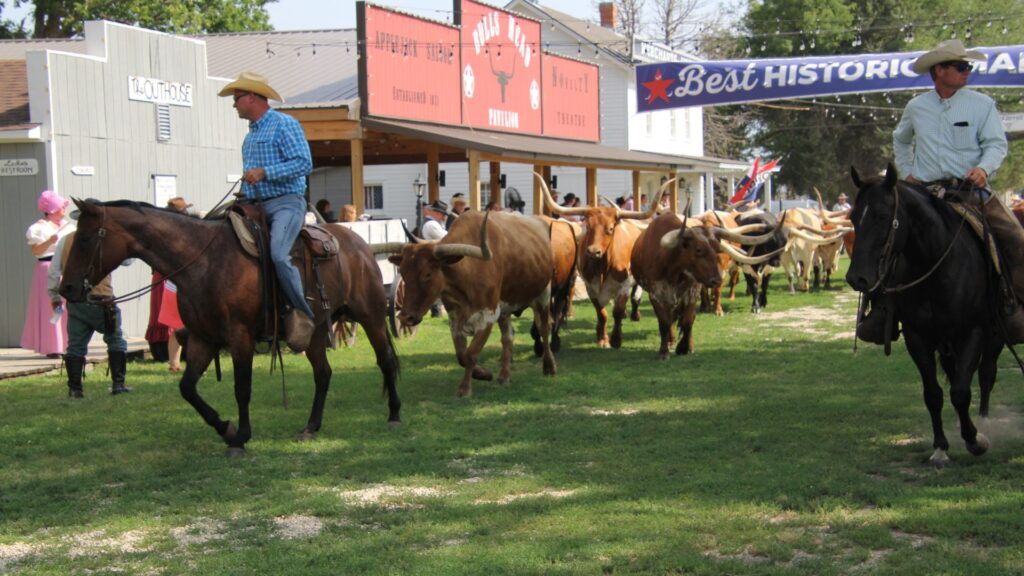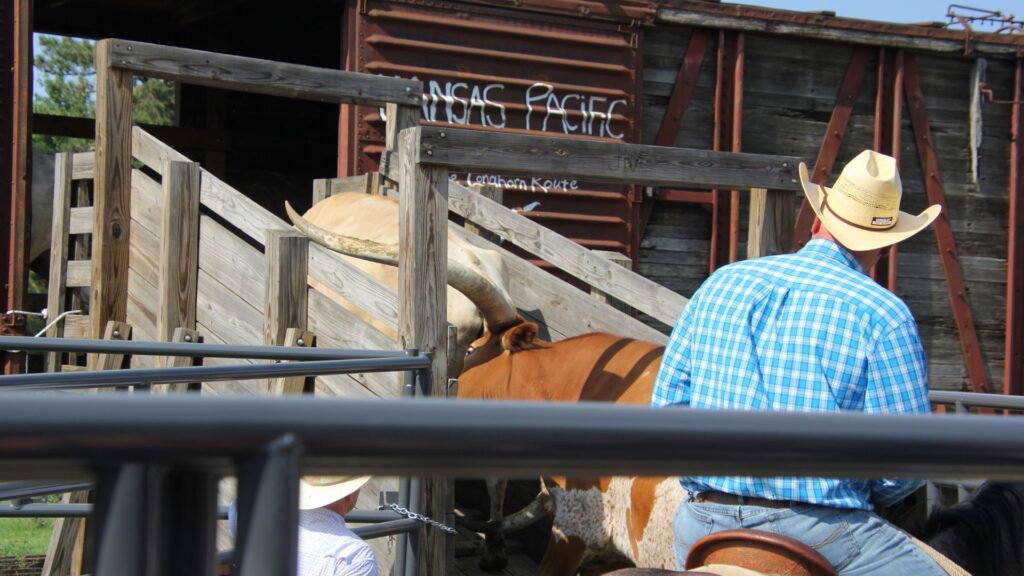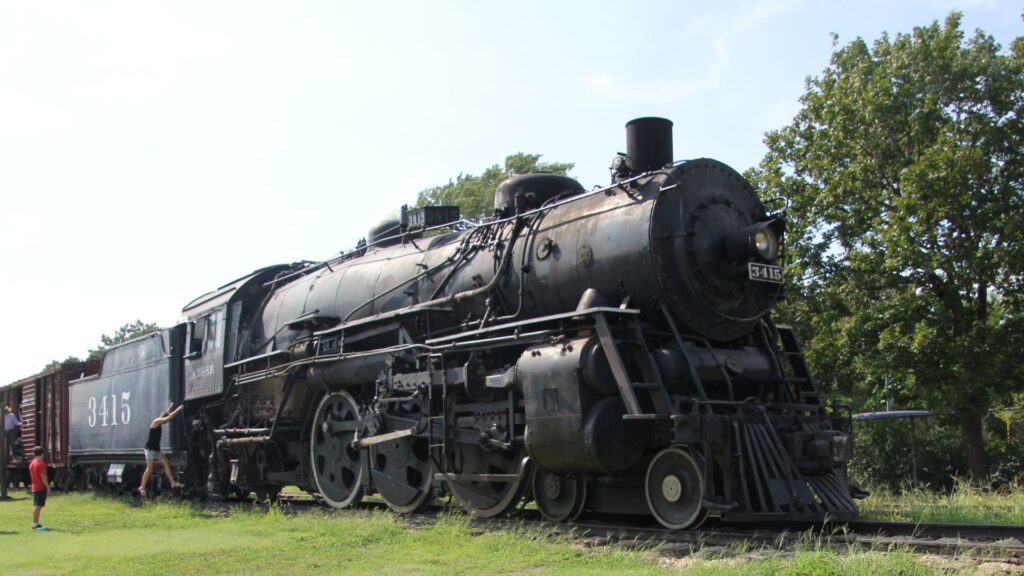Abilene, Kansas, was the first of the cow towns in the Wild West. Today, Old Abilene Town recreates those days with buildings that simulate the 1870s Abilene and museums that tell the history of the Chisholm trail, cattle drives, and Abilene life in the days of Wild Bill Hickok.
Disclosure: Thank you to Visit Abilene Kansas for hosting this year’s Kansas Tourism media event, where we were treated to the welcome event at Old Abilene Town.
Listen to the Podcast
Click here to read the article and view slideshows.
Old Abilene Town
Buildings along Old Abilene Town’s boardwalk include the Alamo Saloon and a general store, among other businesses that existed at that time.
Also on the grounds are one of the first cabins built in Dickinson County, the second church (which doubled as the first schoolhouse), and the carriage house that belonged to T. C. Henry. T. C. Henry is the person who brought the wheat crop to Kansas.
One of the buildings houses a 1:24 scale model of the Old West town. Another building features an extensive exhibit on the Chisholm Trail history. Old Abilene Town is open on weekends, when you may witness gunfights in the streets and tour the buildings.
Slideshow of Old Abilene Town
Abilene and Smoky Valley Railroad
Adjacent to Old Abilene Town is the Abilene & Smoky Valley Railroad, which runs weekend excursions. It’s a great addition to your Old Abilene Town visit.
Events at Old Abilene Town
Events are often held on the grounds, as well. In fact, we visited during a media event, which included stagecoach rides, can-can dancers in the saloon, recreation of a cattle drive, and a performance by a cowboy poet. Here is a slideshow of photos from the media event:
History of the Old West in Abilene
It began in the mid-1860s with a gentleman named Joseph McCoy, an Illinoisan in the agriculture business. McCoy had heard about cattle roaming in Texas that were selling for about four dollars a head. He knew he could get a lot more money for the cattle in cities like Chicago and St. Louis, but he needed to find a way to bring them to market.
Back then, there were no railroads in Texas. The closest railroads were in Kansas. So, McCoy looked for a town where he might be able to set up his business, an area where they would be able to bring the cattle up on cattle drives.
The problem was, there was a ban on cattle drives in several states due to a problem that began in the 1850s. They were doing some cattle drives to other area at the time, taking cattle to steamships on the Gulf Coast, or in some cases, all the way up to Illinois. But the cattle on the ranches that the longhorns were going through were dropping dead of what they named Texas Fever. Years later they discovered that Texas Fever was a tic-borne illness that longhorns were immune to but was deadly to other cattle. So, longhorns not being allowed in several states was an obstacle for McCoy.
Preparing for Cattle Drives
McCoy convinced the Kansas governor to open a trail in that quarantine area where he’d be able to bring the cattle up. He also worked with the railroad heads, who thought it was a crazy idea, but agreed to transport the cattle if McCoy could get them up to Kansas.
Then McCoy looked for a town where he could put his stockyards. After several towns turned him down, he went to Abilene. At the time, Abilene was very small, just a few cabins and a saloon. It also had a railroad stop that wasn’t used for passengers. Perfect for building stockyards and a hotel.
He also hired one of Abilene’s founders, Timothy Hersey, to survey and mark the trail that would connect the trail previously utilized by trader Jesse Chisholm. Chisholm had used the trail when traveling between his trading post in Kansas and his post near the Red River on the present-day Texas-Oklahoma border.
In addition, McCoy sent men to Texas to convince the cattle owners that there was money to be made driving their cattle to market in Abilene.
The stage was set for cowboys to bring the cattle north to Abilene.
Cowboys on Cattle Drives
The cowboys who brought the cattle up the trail made up a very diverse group. Former Confederate soldiers worked together with freed slaves and Mexicans. Many of the cowboys were as young as fifteen years old, because it was a tough job that most men didn’t want to do. Those who did looked forward to what lay ahead of them at the end of the trail. They’d get paid and then hit the saloons, brothels, and poker games. They were out to have a good time.
The town got really rough with all of that going on. Gunfights were common. Several lawmen resigned because they couldn’t handle it.
Tom “Bear River” Smith
The first really tough lawman that came to Abilene was Tom “Bear River” Smith, a former boxer. He was also a former lawman who worked in several places, including New York. While he was in New York, he accidentally killed a kid. He felt horrible about it, and as a result, hated using guns. So, he basically used his firsts rather than his gun. Being a former boxer, he was faster with his fists than a lot of the men were with their guns.
One story is told in which a guy pulled a gun on Smith. Smith pulled his gun out and hit the guy on the head with his gun faster than the guy could shoot.
Eventually Smith was ambushed and killed.
Wild Bill Hickok
Wild Bill Hickok took over as marshal. By that time Hickok already had quite a reputation as being tough and fast with the gun. His unofficial office became the Alamo Saloon. He didn’t do a lot because he knew that everybody was afraid of him and wouldn’t bother him. However, he did have several run-ins with two men: Ben Thompson and Phil Coe. Thompson and Coe owned the Bull’s Head Saloon and were both former Confederate soldiers. Thompson generally kept quiet, but Coe kept provoking Hickok, kept accusing Hickok of bullying Texans and former Confederates.
Hickok’s Run-In with Coe
Abilene townspeople started complaining to Hickok that Coe and Thompson had painted a large, anatomically correct bull on the side of their saloon as an advertisement. They did not like that, thought it was almost pornographic.
Hickok tried to convince Coe and Thompson to remove it, but they wouldn’t. So, during the night, Hickok painted over it. Coe was not happy with that, and he wanted revenge. One night, Coe got a group of cowboys drunk, wanting to incite a riot. They were all outside of the Bull’s Head, and Coe fired two shots, knowing that Hickok would show up.
Sure enough, Hickok came running around the corner to see what was going on. Coe said he had been shooting at a stray dog. Hickok knew better than that and told Coe to drop his gun. Coe pretended to start dropping his gun, then quickly fired two shots toward Hickok. One bullet when through Hickok’s coat. The other missed completely. Hickok shot back and killed Coe.
Hickok Kills Another Man
Just then, as all the drunk cowboys were standing around, Hickok saw somebody come up in the shadows of the dark with a gun. Wild Bill thought it was one of Coe’s friends who was going to kill him. Hickok turned and fatally shot the man.
It turned out that the man he killed was Hickok’s young deputy, Mike Williams. He felt awful about it. Not long after that incident, Hickok was dismissed as Abilene’s marshal, and he never went into law enforcement again. Instead, he joined Buffalo Bill Cody in his productions but left Cody’s organization prior to Cody forming his traveling show.
The End of the Wild West in Abilene
Things had really gotten out of hand in Abilene, and the residents were not happy. They wanted this part of town gone. Not only were they upset about what was going on because of the evil nature, but also, they knew that the town wouldn’t grow. After all, who would want to move to a town with such a reputation?
They ended up voting out the town officials, voted other people in, and cleaned up the town. The end of the cattle drive trail was no longer wanted in Abilene, so the trail end moved west to Ellsworth.
It had been five years since the cattle drives began, with the last one in 1871. There were still about 200,000 cattle in the pens, though, and it took another couple of years for them all to be shipped out by railroad.
If You Go to Old Abilene Town
Old Abilene Town is located near the Eisenhower Museum and Library, as well as other Abilene attractions and is open on Saturday and Sunday afternoons. Visit the website for gunfight show times and other details.
The Abilene & Smoky Valley Railroad runs excursion trains on weekends, as well as occasional dinner trains and other special events. Check the ASVRR website for schedules and other details.
